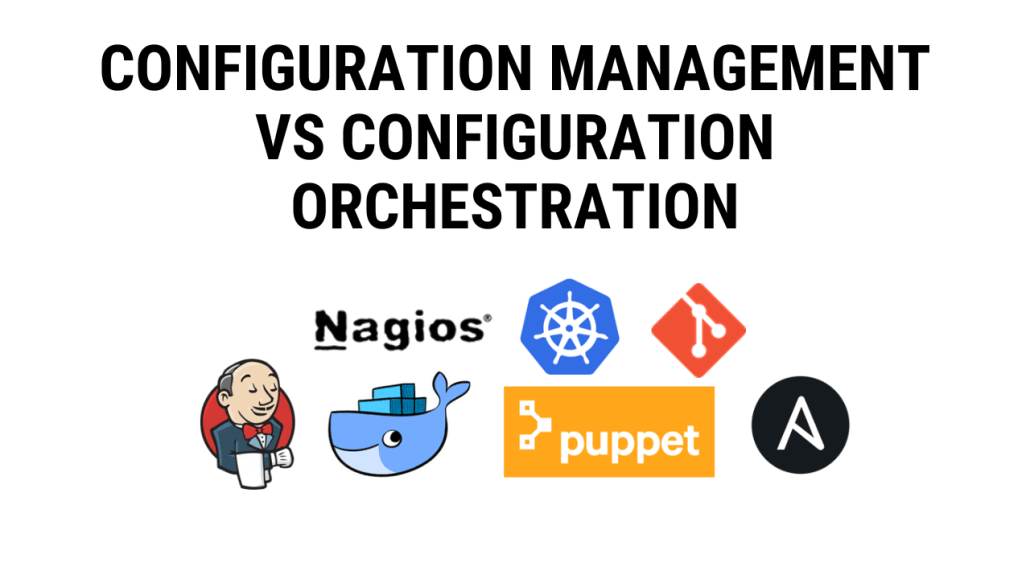Introduction
In today’s modern tech ecosystems, software configuration management and orchestration play vital roles in ensuring efficient and seamless operations. The central theme of this article is to understand the distinctions between configuration management and configuration orchestration, as they both have their unique functions and benefits.

Understanding Configuration Management
Configuration management refers to the process of identifying and controlling the state of a system’s configuration items throughout their lifecycle. Its main objectives include maintaining consistency, traceability, and version control. This concept has evolved over time, adapting to the ever-changing landscape of technology.
Key Components and Processes
Configuration management encompasses several key components and processes:
- Configuration Identification: This involves defining and recording the various configuration items and their attributes.
- Configuration Control: It focuses on managing changes and ensuring that they are properly authorized, tested, and documented.
- Configuration Status Accounting: This process tracks and reports on the current state of configuration items.
- Configuration Auditing: It involves conducting periodic reviews and audits to ensure compliance and identify potential issues or discrepancies.
Exploring Configuration Orchestration
Configuration orchestration refers to the automated coordination and management of various system configurations. Its primary objective is to streamline the deployment and scaling of software systems. Configuration orchestration tools have emerged and evolved to meet the demands of complex and dynamic environments.
Comparison to Configuration Management
While configuration management and orchestration share similar goals, they have complementary roles. Configuration management focuses on maintaining consistency and control over the configuration items, while configuration orchestration emphasizes rapid deployment and scaling through automation and centralized control.
Importance of Automation and Centralized Control
Configuration orchestration relies heavily on automation and centralized control to enable efficient deployment and coordination. By automating repetitive tasks and providing a centralized platform for configuration management, organizations can achieve greater scalability and agility in their operations.
Configuration Management vs Configuration Orchestration: Key Differences
Several key differences exist between configuration management and configuration orchestration:
- Philosophical Disparities: Configuration management emphasizes control and consistency, while configuration orchestration prioritizes rapid deployment and scaling.
- Focus on Scalability and Distribution: Configuration management is typically better suited for smaller, localized environments, while configuration orchestration excels in larger, distributed systems.
- Granularity and Level of Control: Configuration management offers more granular control over individual configuration items, while configuration orchestration focuses on managing large-scale configurations.
- Handling Complex Dependencies Efficiently: Configuration orchestration tools excel in managing complex dependencies and orchestrating the deployment of interconnected systems.
- Role of Human Intervention: While configuration management often requires human intervention for manual updates and changes, configuration orchestration reduces the need for manual involvement through automation.
Configuration Management in Depth
a. Configuration Management Benefits
- Enhanced Consistency Across Systems: Configuration management ensures that all systems have standardized configurations, minimizing discrepancies and improving overall consistency.
- Improved Traceability and Version Control: With proper configuration management practices, it becomes easier to track changes, trace their origins, and maintain version control.
- Facilitated Change Management: Configuration management enables organizations to manage and implement changes efficiently, minimizing disruptions and maintaining system stability.
b. Configuration Management Challenges
- Balancing Flexibility and Standardization: Organizations must strike a balance between allowing flexibility for customization and enforcing standardization to ensure consistency.
- Increasing Complexity in Large-Scale Environments: Managing configurations in complex, large-scale environments can be challenging, requiring robust tools and processes.
- Risks of Manual Errors and Outdated Information: Depending on manual updates and outdated information can lead to errors, inconsistencies, and potential vulnerabilities.
c. Popular Configuration Management Tools
- Puppet: A widely-used configuration management tool that offers automation and centralized control.
- Chef: Similar to Puppet, Chef provides automation and streamlined management of configurations.
- Ansible: Ansible is known for its simplicity and ease of use, allowing for efficient configuration management.
- SaltStack: SaltStack offers scalable configuration management capabilities, suitable for larger environments.
Configuration Orchestration in Depth
a. Configuration Orchestration Benefits
- Rapid Deployment and Scaling: Configuration orchestration enables fast and efficient deployment of software systems, as well as easy scaling.
- Streamlined Collaboration and Coordination: With centralized control and automation, configuration orchestration facilitates collaboration among teams and ensures smooth coordination.
- Efficient Resource Utilization: Configuration orchestration tools optimize resource allocation, minimizing wastage and enhancing overall efficiency.
b. Configuration Orchestration Challenges
- Learning Curve and Potential Tool Complexity: Configuration orchestration tools may have a learning curve, requiring expertise to effectively utilize their functionalities.
- Limitations in Certain Specialized Scenarios: While configuration orchestration excels in many cases, it may have limitations in highly specialized scenarios that require specific configurations.
- Security and Compliance Considerations: Organizations must carefully consider security and compliance requirements when implementing configuration orchestration, ensuring adequate safeguards are in place.
c. Popular Configuration Orchestration Tools
- Kubernetes: A powerful container orchestration tool that enables efficient management of containerized applications.
- Docker Compose: Docker Compose simplifies the orchestration of multi-container applications.
- Terraform: Terraform allows for the provisioning and management of infrastructure resources in a declarative manner.
- AWS CloudFormation: This tool from Amazon Web Services provides infrastructure as code capabilities, allowing for easy orchestration within the AWS ecosystem.
Real-World Use Cases for Configuration Management
a. Case Study: Large-Scale Web Application Deployment
- Ensuring Consistency in Diverse Environments: Configuration management is crucial in maintaining consistency across various environments, ensuring smooth operations.
- Managing Configurations Across Legacy Systems: Configuration management helps organizations handle complex legacy systems and manage their configurations effectively.
Real-World Use Cases for Configuration Orchestration
a. Case Study: Containerized Microservices Architecture
- Streamlining Cloud Infrastructure Provisioning: Configuration orchestration tools simplify the provisioning of cloud infrastructure required for containerized microservices.
- Enabling Immutable Infrastructure Deployments: With configuration orchestration, organizations can easily create and deploy immutable infrastructures, enhancing scalability and resiliency.
Combining Configuration Management and Configuration Orchestration
By combining configuration management and configuration orchestration, organizations can leverage the strengths of both approaches, filling gaps and maximizing efficiency. This enables seamless end-to-end automation and ensures smooth software development and operations.
Summary
In conclusion, configuration management and configuration orchestration are essential components of modern software development and operations. Understanding the distinctions between these concepts and utilizing both approaches appropriately can contribute to efficient and scalable deployments. It is crucial for organizations to find the right balance based on their specific use cases, taking advantage of the benefits offered by each approach.
Frequently Asked Questions (FAQs)
Here are some common questions related to configuration management and configuration orchestration:
Are configuration management and orchestration interchangeable terms?
No, configuration management and configuration orchestration are not interchangeable terms. While both concepts are related to managing and maintaining the consistency of system configurations, they approach this task from different angles.
Configuration management focuses on the control and tracking of configurations throughout their lifecycle. It involves documenting and organizing all configuration items, ensuring their integrity, and enabling efficient change management. In contrast, configuration orchestration emphasizes the automation and coordination of configuration-related tasks and processes. It streamlines the deployment and synchronization of configurations across various systems and infrastructure components.
Can configuration orchestration tools replace configuration management tools?
Configuration orchestration tools cannot completely replace configuration management tools as they serve different purposes. While configuration orchestration tools are vital for automation and synchronization of configurations, configuration management tools provide a broader set of functionalities. Configuration management tools enable organizations to track and control changes, maintain compliance, and enforce policies related to configurations.
However, for organizations implementing DevOps practices, using both configuration management and configuration orchestration tools together can provide a comprehensive solution. This combination allows for effective configuration management and facilitates streamlined automation and orchestration of configurations.
Can I use multiple configuration management or orchestration tools in parallel?
Yes, it is possible to use multiple configuration management or orchestration tools in parallel, depending on your specific requirements and environment. Organizations often have diverse systems and infrastructure components that may require different tools for effective management and orchestration.
However, it is important to carefully plan and consider the interoperability and compatibility of multiple tools. Smooth integration and data synchronization between different tools are crucial to avoid conflicts and inconsistencies that could lead to configuration errors or vulnerabilities.
How do these concepts fit into DevOps practices?
Configuration management and configuration orchestration are fundamental components of DevOps practices, where they play crucial roles in achieving efficient and reliable system configurations.
Configuration management practices enable DevOps teams to maintain consistency, control changes, and ensure compliance with predefined standards. By documenting, tracking, and automating configuration processes, organizations can streamline the deployment and management of infrastructure and application configurations.
Configuration orchestration practices, on the other hand, enhance collaboration and accelerate deployment through the automation and synchronization of configuration tasks. By leveraging orchestration tools, DevOps teams can effectively manage complex and distributed systems, ensuring the alignment of configurations across different environments.
Together, configuration management and configuration orchestration empower organizations to achieve faster deployment, improved reliability, and enhanced scalability within their DevOps pipelines.
What security considerations should be kept in mind with both approaches?
When it comes to configuration management and configuration orchestration, security considerations are of utmost importance. Both approaches can directly impact the security posture of an organization’s systems and infrastructure.
In configuration management, ensuring proper access controls, encryption of sensitive data, and validation of configuration changes are critical for maintaining security. Additionally, auditing and logging configuration changes can help in detecting and mitigating potential security breaches.
With configuration orchestration, organizations should consider secure communication protocols, secure storage of configuration data, and robust authentication mechanisms. It is essential to protect orchestration tools from unauthorized access and regularly update them to address any vulnerabilities.
Ultimately, implementing a comprehensive security strategy that encompasses both configuration management and configuration orchestration is essential for safeguarding sensitive data, enforcing policies, and mitigating potential threats.



